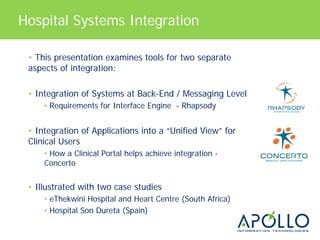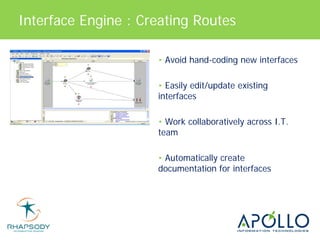Apollo orion ihic2008_final
- 1. Approaches to Hospital Integration Clinical Portal and Interface Engine Brendon McAlevey Senior Consultant Orion Health/Apollo
- 2. Hospital Systems Integration ŌĆó This presentation examines tools for two separate aspects of integration: ŌĆó Integration of Systems at Back-End / Messaging Level ŌĆó Requirements for Interface Engine - Rhapsody ŌĆó Integration of Applications into a ŌĆ£Unified ViewŌĆØ for Clinical Users ŌĆó How a Clinical Portal helps achieve integration - Concerto ŌĆó Illustrated with two case studies ŌĆó eThekwini Hospital and Heart Centre (South Africa) ŌĆó Hospital Son Dureta (Spain)
- 3. Rhapsody Integration Engine What should an Interface Engine Do? - Connect together multiple hospital I.T. Systems - Handle complex format translations (eg. HL7 v.2 -> XML) - Make it easy to create/edit interfaces - Allow real-time monitoring and alerts of faults & errors
- 4. Interface Engine : Creating Routes ŌĆó Avoid hand-coding new interfaces ŌĆó Easily edit/update existing interfaces ŌĆó Work collaboratively across I.T. team ŌĆó Automatically create documentation for interfaces
- 5. Interface Engine: Mapping Formats ŌĆó Create custom mappings ŌĆó Use/edit standard mappings ŌĆó Reduce hand-coded mappings ŌĆó Avoid proprietary code
- 6. Interface Engine: Monitoring ŌĆó Monitor status of routes, communication points, message queues, error logs ŌĆó Access archived messages ŌĆó Stop/start routes ŌĆó Remote access
- 7. Rhapsody at eThekwini Hospital Durban, South Africa
- 8. Interface Engine at eThekwini Hospital ŌĆó 250 Bed Private Hospital ŌĆó Specialist Cardiology Unit ŌĆó Maternity Unit ŌĆó Paediatric Unit ŌĆó 7 Operating Theatres ŌĆó Brand New Facility ŌĆō built 2007, opened 2008 ŌĆó SAP-based Hospital Information System ŌĆó Clinical Systems by GE ŌĆó Integration to SAP systems using Rhapsody ŌĆó Rhapsody Integration Engine
- 9. Concerto Clinical Portal Patient information is typically stored in separate clinical systems, each with its own login and password. A Clinical Portal with Single Sign-On can manage a userŌĆÖs access credentials so that they only need to sign-in once. Once a patient is selected, the clinical user has immediate one-click access to all integrated clinical applications
- 10. Clinical Portal Single Sign-on Centralised enforcement of patient privacy and user security Single Complete Source of Information Unified View of Data from Multiple Sources Supports incremental implementation across a hospital/ enterprise ŌĆ£Best of BreedŌĆØ ŌĆō not ŌĆ£Big BangŌĆØ
- 11. Clinical Portal : ŌĆ£Dynamic Patient SummaryŌĆØ ŌĆó Assembled in real-time from multiple sources ŌĆó Alerts, Recent Results/Orders ŌĆó Document + Results Tree ŌĆó Click-Through to further information
- 12. Clinical Portal : Results Reporting Web-based view of individual and cumulative numerical data, such as laboratory results
- 13. Concerto Portal at Hospital Son Dureta, Spain Spain
- 14. Hospital Son Dureta Palma de Mallorca Balearic Islands, Spain 900 beds Regional reference hospital 50 year-old infrastructure Urban population 375,000 (Palma) Clinical Portal Solution providing: Lab Results Reporting Clinical Notes Emergency Whiteboard Electronic Clinical Orders
- 15. Clinical Portal: Phase One Focus on ED dept where all specialties closely interact Go-Live November 2006 Oracle HTB as Clinical Data Repository RhapsodyŌäó provides HL7 v.3 conversion for data from legacy source systems ConcertoŌäó provides Unified UI ŌĆó ED Whiteboard ŌĆó Results reporting ŌĆó Electronic clinical orders
- 16. Clinical Portal: Electronic Whiteboard ŌĆó electronic version of the traditional ED whiteboard ŌĆó Integrated to existing PAS & ED System ŌĆó Patient status data pulled from multiple systems, eg: -location -responsible clinician -availability of lab results ŌĆó Updated in real time
- 17. Clinical Portal: Phase Two Go-Live April 2007 Second Electronic Whiteboard deployed - Paediatric ED Web-based Clinical Notes for both Emergency Departments Discharge Summaries, automatically populated from Clinical Notes Alerts for Frequently Admitted Patients (notification to clinicians when a patient who is a ŌĆ£frequent flyerŌĆØ presents again in the ED) Expanded Dynamic Patient Summary and Patient Search Searchable History Report for ED
- 18. Clinical Portal: Future Plans ŌĆó Expansion of solution beyond the Emergency Departments ŌĆó Deployment of Electronic Whiteboard on wards ŌĆó Deployment in specialist departments ŌĆó Expanded capabilities for Clinical Orders, Results Reporting
- 19. Summary Back-end integration -A interface engine is the ŌĆ£beating heartŌĆØ of an integrated hospital IT framework - A well-designed interface engine can make integration simpler for hospital I.T. Teams ŌĆō allowing them to focus on more ŌĆ£high valueŌĆØ projects Front-end integration - A clinical portal approach can deliver the benefits of integrated data to clinical users - Using the integrated infrastructure to support better processes, better care
- 20. More Information? Apollo SA www.apollo.gr Orion Health www.orionhealth.com




















